
As winter wanes and spring looms, many athletes choose to announce the bittersweet change of their own season of life, retirement from the sport to embark on a new pursuit. This March, after seven seasons on the U.S. Ski Team, 31-year-old Ida Sargent decided the time had come for something new.
“I knew after Sochi that I wanted to go to one more Olympics,” Sargent told FasterSkier in a call. “So at that point, I committed to another four years and then figured at that point that I would just reevaluate and take it year by year. People had said in the past that you’ll know when you’re ready, and I have to admit that I was a bit skeptical on that and I wasn’t really sure that I would know. But this winter, I was ready. It hit me and I just knew.”
When she towed the line in Ruka for her first World Cup of the season, the classic sprint where she took 27th, she was not aware that it would be her last year doing so. Her decision to retire was formalized as the year progressed.
“It wasn’t even until the season started,” said Sargent. “I was still – I had a great training year, I was pretty fired up. But the beginning of the season I was sick a lot, and I found myself looking at plane tickets home more often than I normally do.”
At a glance, Sargent has competed in two Olympic Games, Sochi and PyeongChang. She started 148 World Cup races with over a third of those starts resulting in a top-30 finish. Known more for her sprinting than her distance skiing, she was top-10 in nine individual sprint events and one distance event. She contributed to two podium finishes in the team sprint with her teammate at both Dartmouth College and the U.S. Ski Team, Sophie Caldwell, once in PyeongChang in 2017 and again in Dresden in 2018. She also landed on the podium individually by taking third in the classic sprint in the PyeongChang World Cup races. Domestically, she has 12 individual wins at SuperTour events or U.S. Nationals, and was this year’s national champion in the classic sprint. Her consistency at the top level throughout her career speaks for itself.
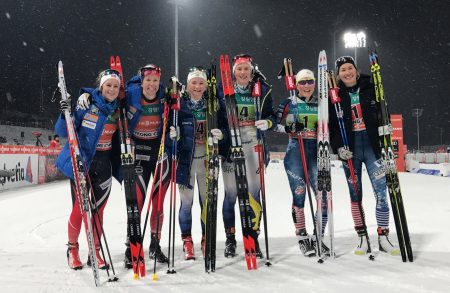
While these results and the journey to attain them have been a positive and satisfying experience, life on the road has its disadvantages. As the novelty of the World Cup athlete lifestyle wore off, the transience and singular focus weighed on Sargent and became a significant factor in her decision to step away.
“I still love the training and I love the racing,” she explained. “But it’s all the time in between the training and racing that I just don’t love – the hanging out in hotel rooms and the time away from home, living out of a duffel bag. That part has been wearing on me, and that was what made me realize that I was ready for a change.
“And while I still love racing,” she continued, “I just am not quite as driven any more and achieving a goal no longer is quite as satisfying. I think the singular pursuit and focus on just racing is not as engaging as it used to be for me. I’m more excited about a broader range of things and new challenges, all of those combined its becoming quite apparent to me that I’m ready for something new.”
While she was burdened by this readiness for change, Sargent was cognizant of not seeming jaded, particularly in front of the group of younger athletes, like USST D-Team members Hailey Swirbul, Julia Kern, Katherine Ogden, and Hannah Halvorsen, who were pulled up to compete at some of the World Cup events this season. She wants only to encourage these women as they continue to chase their dreams.
“I have loved the lifestyle and was so thankful for it at the time, I think it’s just an amazing pursuit,” said Sargent. “I feel lucky to have had the time on the World Cup and on the U.S. Ski Team and going to World Championships and the Olympics. But yeah, for me personally, I’m ready for something new, but that doesn’t mean that those aren’t awesome goals and great trajectories.”
Sargent has been a member of the U.S. Ski team alongside other women who have contributed to the rise and success of American skiing. While the names and faces are changing, Sargent does not feel the momentum will be lost during this transition.
“This year has been really exciting actually – we had big retirements last year, losing Kikkan [Randall] and Liz [Stephen] on our team, who are just such leaders,” explained Sargent. “And I think we were all kind of wondering what the energy would be like without those two. But immediately from the first camp of the year, the energy that the young ones – we call them ‘the guppies’, the development team girls – they just brought this new energy. So it’s been fun to see this new crew coming up and to race some World Cups with them this winter and racing here with them. It’s nice to see that amazing energy that they’re bringing up, and it’s nice to know that the work that we’ve laid down is just going to be built upon and that they’re going to bring lots of great success to the team.”
With highs and lows, the season progressed and Sargent ruminated about her retirement. Surprisingly, her decision was not finalized after persistent illness or races that may not have matched her career best, rather, the resolution came after earning the national title in the classic sprint on the trails she grew up skiing in Craftsbury, VT.
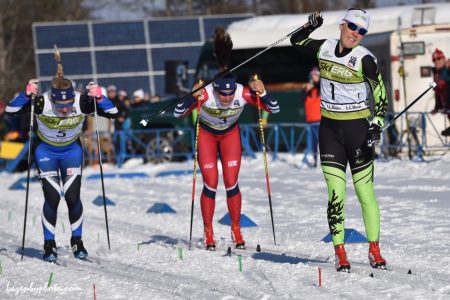
“I think the day that I look back on and remember when I realized I was going to be done was actually after winning Nationals at home,” Sargent shared. “It was really fun, but I was like ‘I think it’s time.’”
She had discussed her decision with her sister and her boyfriend, Pat O’Brien, but had not formally shared her retirement more broadly. Her first time sharing the news beyond that was seemingly equal parts disclosure and realization.
“I think that it was actually just an off-hand comment to a friend who was watching, they were talking about maybe coming up to watch the races in Quebec City,” she recalled. “I was like, ‘Oh, yeah, I think those are going to be my last races.’ I remember saying that and being like, ‘Huh, that feels pretty good actually. That make’s sense to me’. And obviously, I didn’t fully finalize my decision until later, but this year I’ve just kind of known from the beginning and have been trying to embrace all of the opportunities and the team and the amazing lifestyle as much as possible rather than focusing on results at that point.”
In almost 23 years of skiing, Sargent remarkably had only two primary coaches. Her first coach was Pepa Miloucheva, who first worked with Sargent from the time she entered the Bill Koch league at Craftsbury and has since become the director of competitive skiing and the head coach of the Craftsbury Green Racing Project (CGRP) team. When she entered high school at Burke Mountain Academy, Sargent began working with Matt Whitcomb, who is now a coach for the U.S. Ski Team. The only time she was not working with either Whitcomb or Miloucheva was during her time at Dartmouth College, where she was coached by Cami Thompson, and even then, she trained in Craftsbury during the summers.
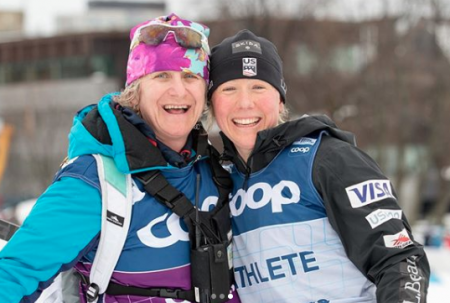
In her professional career, Sargent has trained with Miloucheva and CGRP throughout the summer, transitioning to working with Whitcomb at USST camps and throughout the winter race season. Sargent attributes the steady progress she made throughout her development into an elite skier to predominantly working with these two.
“I’ve been very lucky to have a lot of consistency in my coaching,” she explained, “and I think that’s allowed me to make gradual consistent progress throughout my career without having any major changes.”
While these coaches certainly impacted Sargent’s development, career, and life, her impact on her coaches was equally great.
“Ida is definitely one of those athletes that’s more like a gift to the coaches, than the coaches are a gift to the athlete,” Matt Whitcomb shared in a call. “She’s one of the few reasons that has made coaching for so long so easy to do.”
He added, “People like Ida are so important to the longevity and the well being of the teams that they’re on. So I’m just feeling really lucky as I reflect on her career.”
Even from a young age, Sargent loved to compete and demonstrated the potential to be great.
“She really likes racing, she was really fun to work with,” said Miloucheva. “Even when she was really young, she was really really quick with transitions, and she had this ability to accelerate. I knew from a young age that she could be a really good sprinter.”
Coupled with her natural talent, Sargent is fiercely competitive, but this drive is tempered outside the realm of competition by a genuine care for others.
“She was and always has been extremely competitive,” Whitcomb explained. “We laugh about that on our team a little bit – whether it’s a small game in the evening that we’re playing with the team or a World Cup sprint, she’s extremely competitive.
“What stands out in contrast to that level of competitiveness is that she’s one of the athletes that will always take time to search her surroundings and see how people around her are doing,” he continued. “She’s been one that – before I even knew that I was starting to stress out, she would ask me how I was doing. She just has a good sense for people and an incredible sense of caring.”
After guiding Sargent from her junior years through her retirement, both Whitcomb and Miloucheva have plenty to be proud of, but the memories the two will look back on most fondly arrived at opposing ends of her career.
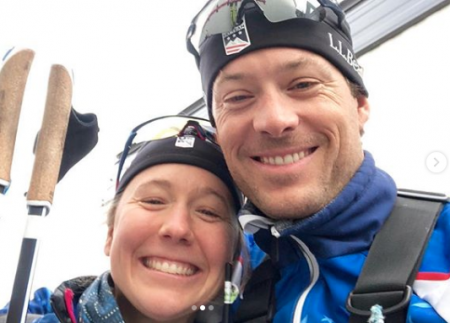
“It’s always fun watching athletes at the podium,” shared Whitcomb. “Ida had three World Cup career podiums, each of which brought a tear to my eye, but perhaps the moment that I was most proud of was just watching her last race. She did not put together the season that she had hoped to, as is often the case with retiring athletes. It is just difficult to stay fast and something was missing a little bit this year. But she crossed the finish line at her last race in Quebec with a fist over her head in celebration that I was able to see from across the stadium. That was probably my proudest moment, just watching the actual conclusion of an athlete’s World Cup career.”
Miloucheva looks back to Sargent’s youth and to her first World Cup race.
“When they were young kids, I used to just love when they finish and just look at me and say, ‘Are you proud of us?’” Miloucheva remembered nostalgically. “That was really amazing. I loved when she came from her World Cup and brought me her bib and said ‘Thank you for getting me there.’ It’s all just pretty amazing.
“It’s still such a great feeling that she got so far,” she continued. “She’s such a great human being.”
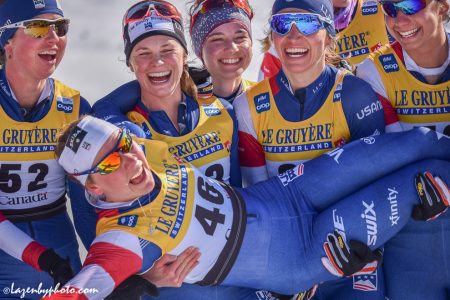
As she reflects back on her own highlights and fondest memories, Sargent sees past her top results to the people with whom the journey was shared.
“I think looking back, it will definitely be the times we spent as a team just out training and at the races and living on the road – I think that those moments will stand out much more than any race result,” Sargent shared. “It’s that community and having that support system and being part of something bigger than yourself is going to be my lasting memory from the sport. I think that individual pursuit is great, but it’s the community and the inspiration for the younger generations and the teammates who have supported me and I’ve been able to support back… We’ve worked together to build something bigger than just our individual results. That’s what I’ll look back on.”
In addition to contributing to the rise of women’s skiing on the national team, Sargent has represented Craftsbury during a time where the center has blossomed into a rich nordic ski community. Her love for the center and gratitude for what is has provided her is clear.
“The Craftsbury community is really a special place,” shared Sargent. “I feel very lucky to have been part of the community there and to continue to be part of the community there. When I was first part of the Craftsbury Nordic Ski Club as a junior or as a young skier, there were probably 10 or 15 of us skiing at any time, but now because of the work that Anna [Shultz, head junior/Bill Koch League coach] and the other junior coaches have done, and Pepa, and just the work of Judy and Dick Dressigacker [who own the center], now there are over 100 kids in the competitive ski programs and almost that many more in the recreational ski programs. So to be part of that is something that I will always be very proud of and something that I am also very thankful for.”
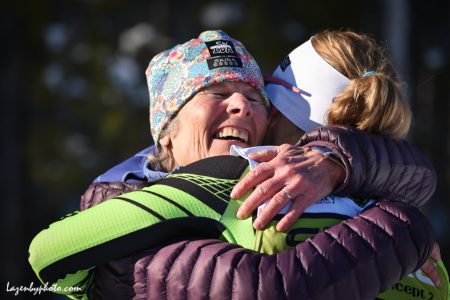
While Sargent was served by the Craftsbury community, the community was perhaps equally served by her presence.
“As Ida is on the National Team, all the younger generation of kids, they can look up to her,” Miloucheva explained. “All the younger kids – everybody knows Ida, and when she’s around and when she goes and skis with them, it’s just such a fun way to have practice.”
The fruits of Sargent’s hard work have been an inspiration to other Craftsbury skiers, young and old.
“All the younger kids, for them, Ida is like an idol, even now,” said Miloucheva. “When she announced her retirement, all the younger kids, they’re all so sad about the fact that she’s retiring.
“The same thing with the masters,” she added. “Everyone knows who she is. She grew up there, it is her home.”
In the next chapter of her life, Sargent will be heading back to her alma mater, Burke Mountain Academy, where she will teach Biology, Chemistry, and Statistics. She will also live on campus and serve as a dorm parent for boarding students. She does not see herself taking on a major coaching role in the near future, but she does hope to help with the local Bill Koch League to help regrow the cross country ski program in the Burke area. While Burke and Craftsbury are roughly an hour apart, Sargent also hopes to stay involved and to continue to contribute to the community there.
“I will continue to be looking for ways to give back to the community or to stay involved even if I’m not living at Craftsbury in the next year or two or wherever I end up,” said Sargent. “I think that extends beyond just the Northern Vermont community to greater Vermont and New England and just the entire US ski community. It’s a small sport, but we’re all very close, and I think it’s a very supportive community, and together – there’s so much individual energy that combined, we can create something bigger than just all of those individual skiers.”
The Craftsbury community will certainly welcome Sargent back with open arms in whatever capacity she chooses to stay involved.
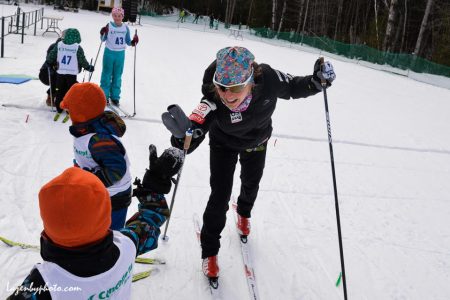
“I still hope that she’ll be back,” said Miloucheva optimistically. “She’s going to have her job at Burke, but she’ll still be visiting, she’ll still be working with the younger kids, she will still join us for some workouts, especially when I need her to push a little bit of speed for the other athletes.”
Finally, Sargent left young skiers with some advice on their journey in the sport based on her own experiences. As Alayna Sonnesyn illuminated earlier this year, after high school, the “pipeline” to making the national team or the Olympics can be difficult to navigate. Sargent explained that the path doesn’t need to be as linear as one might think.
“The advice that I would give to young skiers is that there is no one right way to do it. If you start on one path, that doesn’t mean that that is the ultimate path that you’re going to take, it’s easy to do one thing and then if that’s not working or is not what is best at that moment, switch and do something else. After high school, I thought that I wanted to ski full time and wanted to make the national team and just wanted to do that solely and I wasn’t that interested in going to college.
“So I took a PG year at Burke,” Sargent continued. “But once I was actually trying to train full time, I realized that I wasn’t quite ready to do that. So after one PG year, I went to Dartmouth and raced for Dartmouth for three years. In my junior year, I made the US Ski Team and then finished out my college career with more part-time college, and then became a member of the Craftsbury Green Racing project and have been training with Craftsbury and the national team since then. So I guess I did the PG year, I did full-time college, I did part-time college and full-time skiing over the course of my career and I think that was what was best for me at those times.”
Rachel Perkins
Rachel is an endurance sport enthusiast based in the Roaring Fork Valley of Colorado. You can find her cruising around on skinny skis, running in the mountains with her pup, or chasing her toddler (born Oct. 2018). Instagram: @bachrunner4646



